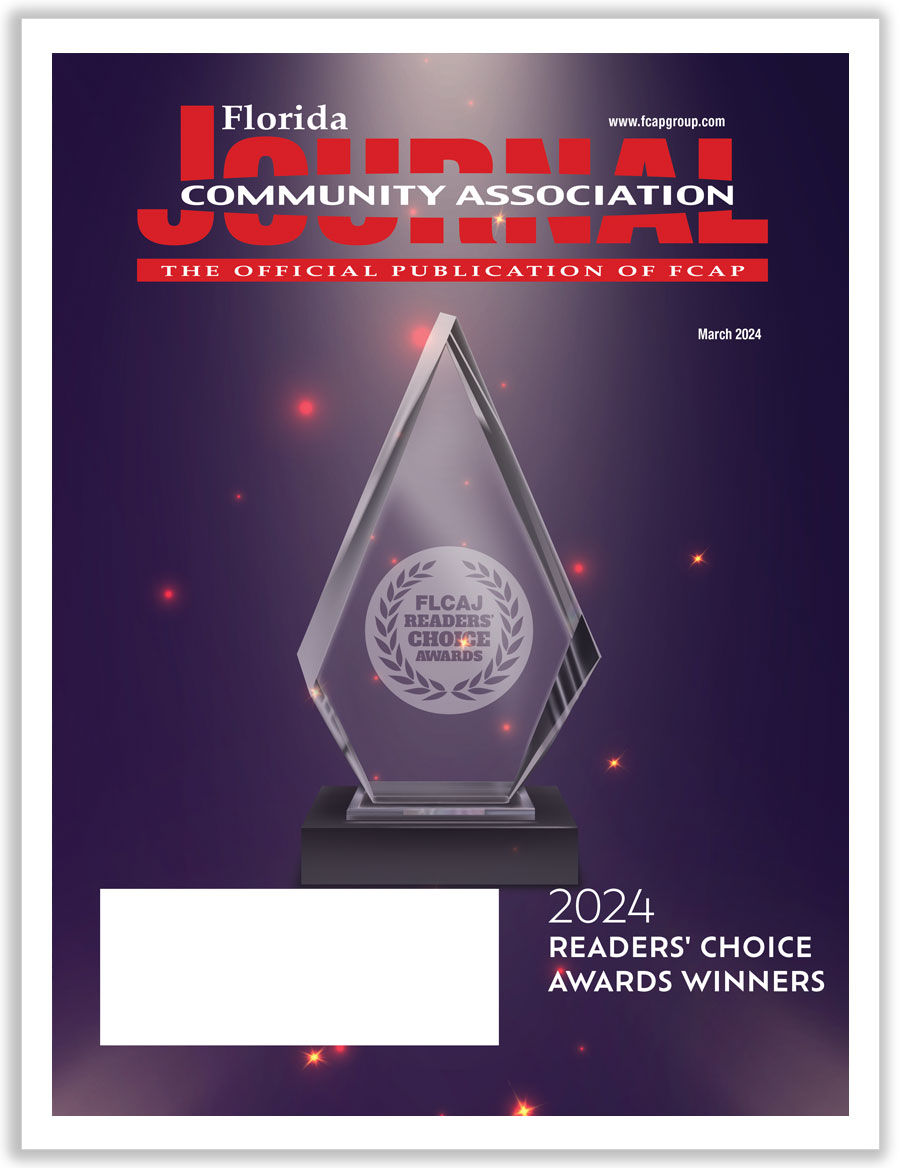
Obstructing Opportunity…But Prepared for Problems
By Kathy Danforth / Published October 2016
Safety and security are multi-faceted aspects of community living—responsibility lies with both the individual and the community as a whole; they are of utmost importance, yet their success is usually marked by “nothing to report;” and they involve predicting the improbable as well as preparing for likely-but-disliked scenarios. Individual residents, the association, and local professionals all play a role in protecting communities from fire and crime.
Fire
Casia Sinco, Chief with the Florida Bureau of Fire Prevention, reports, “In 2014, there were approximately 4,600 fire incidents in multi-family dwellings and almost 17,000 in single-family homes. According to the 2015 annual report, the leading cause of home fires, with 26 percent, was cooking.” Outdoor grills are another common cause, and Sinco notes, “Under the state fire code, no grills are permitted on balconies. On the ground floor, they need to be away from the home or deck. The main way to prevent cooking fires, indoor or out, is to not leave the heat source unattended.”
Electrical devices are a frequent source of fire, according to Sinco. “Electrical equipment can start a fire through an electrical short, overheating, or improper use. Heating blankets should not be left on overnight or be near combustible items. Extension cords are not built for a continuous load, so they should not function as permanent wiring. Also, all cords, surge protectors, etc., should be tested by a nationally-recognized testing laboratory such as UL™ since you tend to get what you pay for.” Sinco shares, “One thing we are finding is that building fires burn quicker and hotter than they used to. There’s nothing to do about it, but be aware that because of the amount of combustibles we use now and the types of materials our furniture is built from, fires spread much faster.”
Despite the best prevention, detection and response are needed. “Smoke alarms should be tested monthly and batteries changed twice per year for most alarms,” advises Sinco. “Even if it is a 10-year [battery life] alarm, it should be tested. Communities should ensure that exits and stairwells are free of clutter and not locked or blocked. All residents should have a meeting place and an escape plan and practice it.”
Living in a high-rise removes some escape options, and Sinco stresses, “Make sure you know the location of all exits in case one is blocked by fire. Always use stairs instead of the elevator; there is a possibility the wiring could go, or the fire department may need the elevator, and you don’t want to block them. Test doors for heat before opening, and close all doors behind you,” Sinco points out.
Crime
Bill Gonsalves, Master Officer with the Naples Police Department, advises that regardless of the layers of protection an association provides, “Recommendations for reducing crime ultimately come back to the homeowner. The most important protection for a resident in a homeowners association or a condominium is to keep your doors locked, whether you’re home or not. Gated
communities are great at keeping cars out, but people jump fences,” he explains. “In access-controlled condominiums, often thieves are brought in by people because people typically hold a door open for someone right behind them.” In that situation, Gonsalves recommends, “Talk to them. Ask them what unit they are in if you don’t recognize someone entering behind you.
“There are many ways to enter,” Gonsalves observes. “Doors are propped open and tradesmen gain access. Trespassers fit the area by dress and age, and then just try doors, which gets us back to rule number one: always lock doors, windows, and sliding glass doors. If balconies connect, someone can enter an empty unit or one in remodeling and go balcony to balcony checking sliding glass doors. If there’s a garage, lock the interior door also because people can get into the garage and then enter the house.”
Theft from vehicles is a common crime, which again falls back on the homeowner as the last line of defense. “Secure valuables inside or at least out of plain view, and lock the car,” Gonsalves states. “In an open HOA, cars may even drive into your driveway to gain access to your vehicles or home.”
Lights! Cameras! and Action! (activated systems) are important for both the association and individual homeowners in HOAs. “Even for communities with a dark sky approach or sea turtle concerns, a community can work around it with motion-sensor lights and different types of lighting,” says Gonsalves. “The best way is to contact the city or county natural resources department to find out which lights can be used.”
Landscaping, as well as darkness, can conceal criminals, and Gonsalves notes that Crime Prevention through Environmental Design comes into play. “Canopies should be in the six- to eight-foot range, and nothing should be over two feet tall around windows or where someone could hide. Anything with thorns is a good barrier—that does work!” he comments.
“Cameras are great; there’s no question,” states Gonsalves. “At the front gate, capturing license plates is perfect for a lot of reasons, including tracking damage to the gate and knowing who is on the property. Common areas, parking garages, and secluded doors that may be propped open are good areas for surveillance. Cameras can be paired with motion-sensor alarms for situations, such as a clubhouse when it is closed.” For communities able to make the investment, infrared cameras can be an effective addition. “Depending on the system, you may be able to track a trespasser through the property,” according to Gonsalves. For individual homeowners, cameras and motion-sensor lights are also a plus as a deterrent and aid in identifying wrongdoers.
Resident involvement can be a great help in fighting crime. “The more eyes, the better,” states Gonsalves. “Programs such as Citizens on Patrol, where volunteers with special training drive around as observers, can be very helpful. If a community sets up Neighborhood Watch, residents learn what law enforcement needs to know: what is suspicious loitering, prowling, trespassing, etc. However, anyone can call law enforcement if something doesn’t look right, and the more details the individual can provide, the more helpful it is. We check if a person or vehicle is out of place, and it’s always an opportunity to dispel fears.”
Resources
Local police and fire departments can assist associations through education, assessment of risks, recommendations, and ongoing involvement. “When the fire department responds to a fire, it shouldn’t be the first time they see the community or interact with the residents,” says Sinco. “Though the possibilities depend on the manpower at an individual department, most fire departments want to be involved in education and provide input and advice on procedures and escape planning. A good relationship helps the fire department with pre-planning and evacuation, and their involvement makes residents more fire-conscious.”
“Having the manager or board representative meet with local fire and law departments is always good,” according to Gonsalves. “It’s also positive to have local law enforcement, EMTs, and fire department personnel at a community meeting. The responders can get the lay of the land, and private communities can invite law enforcement to conduct drive-through patrols. For emergency response, it is helpful to have street numbers clearly visible for first responders and in large communities to have a direction board or map.”
“Local law enforcement often offers community outreach/crime prevention programs,” Gonsalves advises. “Police often provide security assessments of the community property as a whole as well as for individual homes. Services differ depending on the size of the agency, but always start at the local jurisdiction level.”
Besides local law enforcement, Gonsalves recommends additional sources of information to use and share with residents:
• Florida Crime Prevention Association—www.floridacrimeprevention.org
• Financial Industry Regulatory Authority—https://finra.org
• National Crime Prevention Council—www.ncpc.org
• Federal Trade Commission—www.ftc.gov
Since identity theft and scams are the number one crime currently, some information on these issues is provided on these sites.
Association boards and management set the atmosphere for the security that residents enjoy in their community, both through the actions and physical measures they put in place and the focus they place on these issues. Numerous resources and tools are available to make your community unattractive to troublemakers yet ready to respond if the need arises.
Tips to Avoid Identity Theft and Scams
TRC Worldwide Engineering Restoration
To minimize the chances of identity theft, Gonsalves recommends:
• Monitor accounts on a regular basis to check that there is no activity you did not initiate.
• Check your credit reports, preferably staggering each of the three credit bureaus throughout the year.
• Keep credit cards to a minimum. Activate alerts for high purchase amounts and out-of-area transactions.
• Phone scams have different stories—the IRS scam, jury duty scam, power company shut-off scam—but they all end up demanding money. Older people are often more vulnerable because they are afraid of authority, such as someone impersonating the IRS, power company, or sheriff. They may be embarrassed and aware that they forget some things, so they just pay. Or, the “grandparent scam” involves a grandchild in trouble calling in need of money and requesting, “Please don’t tell mom and dad because they’ll be so upset.” Caller ID can be misrepresented, so always look up the number for yourself in case of doubt. Never give out sensitive information over the phone unless you initiated the call and trust the other party. If you receive a suspicious call, just hang up. Law enforcement will not call you with advance notice of a warrant, and any phone call requesting payment with a prepaid card is almost certainly fraudulent.




